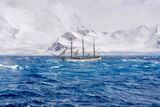
The ill-fated ship Endurance, which famously sank in the Antarctic in 1915, may have faced its tragic end due to structural weaknesses. Recent research led by polar explorer and scientist Jukka Tuhkuri has revealed that flaws in the vessel’s construction could have compromised its ability to withstand the harsh conditions of the region. His findings, published in the journal Polar Record, suggest that the ship was not adequately designed for the extreme challenges it encountered during its expedition.
Investigation into the Endurance’s Structural Integrity
The Endurance embarked on its journey in January 1914, aiming to be the first to traverse the Antarctic continent. Unfortunately, the ship became trapped in pack ice after losing its rudder and ultimately sank in the Weddell Sea. For over a century, the wreckage remained hidden beneath nearly 10,000 feet of ice until its discovery in 2022, remarkably preserved and now designated as a protected historic monument.
Seizing the opportunity, Tuhkuri, a professor of solid mechanics at Aalto University in Finland, undertook a thorough investigation of the ship’s design. He analyzed expedition diaries, Shackleton‘s correspondence, and conducted a naval architectural analysis, uncovering critical insights into why the Endurance sank.
In a press statement, Tuhkuri noted, “Even simple structural analysis shows that the ship was not designed for the compressive pack ice conditions that eventually sank it.” His exploration revealed that compared to other polar vessels of its time, the Endurance exhibited “several structural deficiencies,” including weaker deck beams and a longer machine compartment that significantly weakened the hull.
Shackleton’s Awareness of the Ship’s Limitations
Interestingly, Tuhkuri pointed out that Shackleton appeared to have been aware of these limitations. In his correspondence, Shackleton expressed frustration with the ship’s design and even preferred vessels from earlier voyages. He had suggested diagonal beams for another polar ship, which had proven successful in enduring similar icy conditions.
“The danger of moving ice and compressive loads — and how to design a ship for such conditions — was well understood before the ship sailed south,” Tuhkuri stated. “We really have to wonder why Shackleton chose a vessel that was not strengthened for compressive ice.”
While speculation about financial pressures or time constraints exists, the reason behind Shackleton’s choice remains uncertain. The lack of diagonal beams and other structural reinforcements ultimately led to the ship’s vulnerability against the Antarctic ice.
The enduring legacy of the Endurance lies not only in its tragic fate but also in the extraordinary resilience of its crew under Shackleton‘s leadership. Despite the ship’s demise, the expedition remains a defining narrative of survival during the Heroic Age of Antarctic Exploration.







